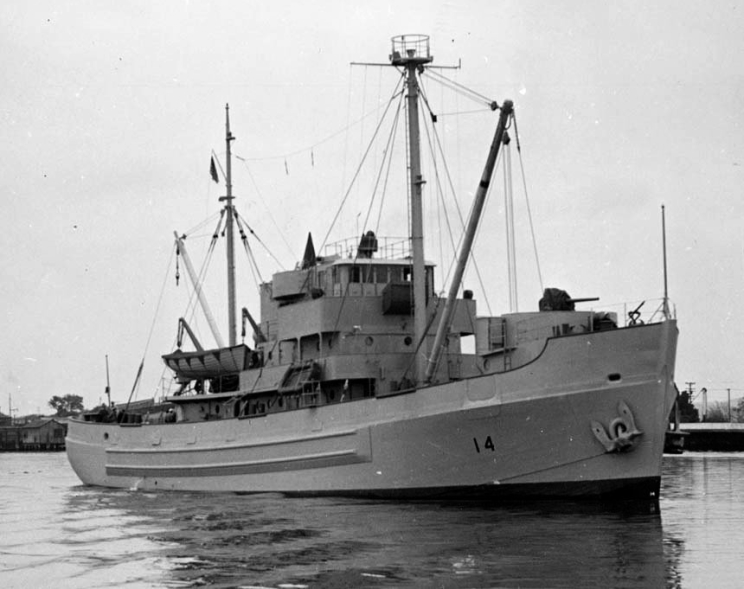|
One who has not been there can only imagine how difficult it was to identify a target in a World War II submarine. There are only a few people still alive that know the feeling of firing a torpedo at the that target and knowing it was destroyed. One feeling no submarine commander wants to know is the feeling of sinking one of your own ships. However on a January day in 1945 one U.S. Navy submarine commander had that horrifying feeling. USS Extractor ARS-15 was a navy salvage vessel built in 1943 and commissioned on Mar. 3, 1944. She sailed for Hawaii on May 8 and arrived on the 20th. From there she sailed to Eniwetok in the Marshall Islands arriving on June 6, 1944. Her crew went to work straight away and remained busy. They repaired engines, cleared fouled propellers and made various underwater repairs to merchant and warships. Towing and salvaging of damaged vessels as well as assisting in pulling grounded ships back into deep water. This continued until Aug. 7, 1944 when she was ordered back to Pearl Harbor. Extractor arrived back at Pearl on the 23rd and underwent repairs and a command change. Lt. (j.g.) H. M. Babcock took command at the end of August or beginning of September. On Sept. 19, 1944 Extractor joined convoy PD-93 towing two U.S. Army barges bound for her old stomping grounds at Eniwetok. Making about 6 knots the trip to the Marshall Islands took until late in the afternoon on Oct. 7. On the 12th Extractor sailed for Ulithi in the Caroline Islands. She took over towing the barracks barge APL-14 on Oct. 17 and arrived at her destination on Oct. 21. While at Ulithi the crew again was involved in many salvage operations and even search and rescue operations. Departing Ulithi on Dec. 1 her next stop was Guam where she arrived on Dec. 3, 1944. From there she made voyages to Tinian and Saipan and continued to assist vessels at sea. On Jan. 21, 1945 she was ordered to sail to the Philippines, for this voyage no escort was provided. At the same time USS Guardfish SS-217 under the command of Commander Douglas T. Hammond, USN, was en route to Guam from her patrol area in the Luzon Strait. At 2030 on Jan. 23 the SD radar on Guardfish picked up a target at 11,000 yards. Visual contact was not made, but they kept the target on the radar and followed. At 2310 a signal was sent to ComSubPac and ComTaskGroup 17.7 asking for information on friendly forces in the area. A watch was then set up to listen for signals from the target. Nothing was heard and it took until 0113 on January 24, 1945 for the message from ComSubPac to be returned. They were told that no friendly submarines were in the area, but that if the target was a surface ship it was probably a friendly since they were in a Joint operation zone. At 0338 ComTaskGroup 17.7 signaled that no friendly forces were in the area and took care to remind them that they were in a Joint zone. Hammond got in front of his target by 0600. At 0620 the target was finally sighted through the periscope. Hammond made four observations and his executive officer made a further two, both agreed that the target was an I class Japanese submarine. The target was sighted about ten minutes before sunrise with an overcast sky and intermittent rain squalls, not exactly the best conditions to make a positive identification. They were about midway between Guam and Luzon when at 0620:20 Hammond fired four Mk 18 torpedoes at the target. The first explosion was heard one minute and eighteen seconds after it left the tube, a second explosion occurred eight seconds later. At 0623 after the smoke had cleared Hammond looked through his periscope and saw the stern rise out of the water and "realized with great concern that we had not hit a submarine". The boat surfaced at 0630 and moved toward the position where the ship had gone down. He had made the most terrible mistake a submarine commander could make, he had sunk one of his own ships. The rescue of the survivors was commenced immediately and by 0815 seventy-three men, including the commanding officer, had been picked up, sadly six men were unaccounted for. They continued to search for the remaining men until 0909 when it was determined that they had gone down with the ship and the search was abandoned. At 1156 the signal to ComSubPac and ComTaskGroup 17.7 was made and the details of the terrible mistake were made known. Their tenth war patrol ended at Guam on Jan. 26, the only ship sunk being USS Extractor. I have not been able to learn if the navy took any action against Hammond, but he was not relieved of command until July 29, 1945 after the twelfth war patrol. No doubt he carried the memory of that day to his grave. |
© 2014 Michael W. Pocock MaritimeQuest.com |
 |
USS Protector ARS-14, same class as Extractor. |
Roll of Honor |
 |
In memory of those who lost their lives in USS Extractor ARS-15 "As long as we embrace them in our memory, their spirit will always be with us" |
Name |
Rate |
||
Bahrey, Walter S. |
Seaman 2nd Class (USNR) |
||
Burgess, Bob R. |
Radioman 3rd Class (USNR) |
||
Frazier, Tommie L. |
Electrician's Mate 3rd Class (USNR) |
||
Orgeron, Alvin C. |
Ship's Cook 3rd Class (USNR) |
||
Taylor, William H. |
Seaman 1st Class (USNR) |
||
Thompson, Raymond E. |
Seaman 2nd Class (USNR) |
||
To submit a photo, biographical information or correction please email the webmaster. |
2005 Daily Event |
||
2011 Daily Event |
2013 Daily Event |
|